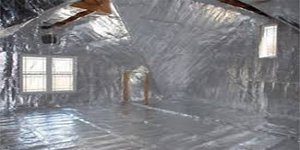Radiant Barrier and Reflective Insulation Prices, Reviews & Pros vs Cons

Radiant barrier and reflective insulation can help reduce the heat brought into your home by reflecting it, as opposed to slowing the transfer of heat like most other forms of insulation. It can be especially effective in high temperature climates and reduce overall energy costs.
What are Radiant Barriers and Reflective Insulation?
Typically used to insulate attics, radiant barriers can block the transfer of heat by reflecting it out the roof. Heat that builds up on the shingles is prevented from entering the home, keeping the attic and the rest of the house cool. They usually come in sheets with a highly reflective surface on one or both sides.
Request Insulation Installation Price Quotes Using Our Free Tool
Get connected to the top rated insulation contractors in your area and get free competitive estimates. No obligations to hire, ever!
Similar to radiant barriers, reflective insulation is an effective way to block the transfer of heat. It generally comes in sheets made of a polyethylene bubble film that is sandwiched between two layers of reflective film, although some only have reflective film on one side. The middle layer provides an additional barrier against heat transfer and added strength. For reflective insulation to truly block heat transfer, air space is required.
How Insulation Works
Most insulation works by slowing or trapping heat as it flows through, keeping the home at optimal temperatures. Radiant and reflective insulation works by reducing any radiant heat gain. It is best to install it in a way that will minimize the amount of dust that can accumulate on the reflective surface, as dust will reduce the reflective capability of the insulation. As the sun heats the roof, the hot roofing material radiates the heat it has gained into the attic or under-roof area. Radiant or reflective insulation reduces that heat transfer and works best when it is perpendicular to the energy that is striking it. In warmer climates, it may just be the insulation solution you need.
The Difference Between Radiant and Reflective
The biggest difference between radiant barriers and reflective insulation is the way they are installed: radiant barriers tend to be installed with one reflective surface facing a large, open air space, while reflective insulation is usually installed within cavities that can provide air space between the insulation and cavity materials.
How Much Do Radiant Barriers and Reflective Insulation Cost?
The cost of radiant barrier or reflective insulation depends on the material, R-value, and size of the insulation, as well as the vendor you choose. These are some general pricing guidelines to give you an idea as to what you will pay for radiant barrier and reflective insulation.
- Reflectix Radiant Barrier Insulation, 24” x 25’, double sided reflective, with staple tab, price range: $21.65 to $23.05
- Reflectix Radiant Barrier Insulation, 16” x 100’, double sided reflective, with staple tab, price range: $40.63 to $42.15
- Arma Foil Radiant Barrier Insulation, 25.5” x 235’, double sided reflective, reflective aluminum breathable foil, 500 sq. ft. coverage, price range: $69.95 to $89.95
- RadiantGUARD ULTIMA Radiant Barrier Insulation, 48” x 125’, double-sided reflective, reflective aluminum breathable foil, price range: $99.00 to $109.00
- Reach Barrier Radiant Barrier Insulation, 48” x 250’, single side reflective, with single air, price range: $232.58 to $236.25
- Ultratouch Radiant Barrier Insulation, 48” x 75’, reflects up to 97 percent of radiant energy, single side reflective, price range: $172.38 to $180.96
These are prices for individual units. The amount of insulation you need for a job depends on the R-values you need and the type of insulation.
Radiant Barrier and Reflective Insulation Reviews
Customers that utilize radiant barrier or reflective insulation often boast of their durability and lightness in comparison to other insulation types. Unlike other forms of insulation, it does not degrade or absorb moisture and is easy to work with. Especially in warmer climates, customers find that it is incredibly effective in keeping their homes cool. However, there have also been those that have said that while it is effective in warmer climates, colder climates require combining it with other forms of insulation. It also tends to be more expensive than others and poses the risk of becoming an electrical hazard. Make sure to thoroughly research both the type of insulation and any consumer reviews before any purchases.
Author: Angela Escobar







